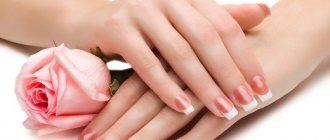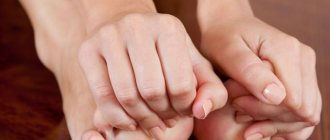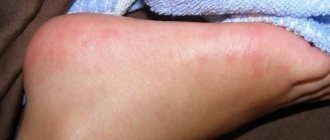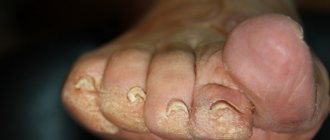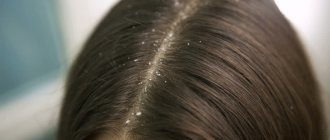Why does eczema occur on fingers?
The exact causes of eczema on the fingers are still unknown. Immunological disorders play a decisive role in its development. The onset of the disease is provoked by external or internal factors, and they may differ from person to person.
What causes eczema on the fingers:
- constant contact with aggressive chemical components or metals;
- dry air, severe frost and other types of thermal effects;
- insufficient hand hygiene;
- frequent mechanical damage, wounds and abrasions on the hands;
- allergic reaction to food;
- hereditary predisposition;
- disorders in the endocrine and digestive system.
Dyshidrotic eczema on the fingers is especially widespread. Its name is explained by the fact that previously the development of the disease was associated with blockage of the sweat glands. The pathology often affects the skin of the palms. Its development is promoted by hyperhidrosis - excessive sweating.
Vesicles - water pimples on the hands: what are they?
The appearance of a rash on the hands may indicate the presence of the following pathologies:
- Eczema, allergies. It may occur as a result of taking medications, eating certain foods, or using detergents.
- Mechanical damage. These include burns, insect bites, and irritations.
- Viral infection. It is not uncommon to see signs of herpes or chickenpox on the hands58.
- Scabies. In addition to watery pimples, peeling, weeping wounds, itching, which is especially intensified at night, and scabies appear58.
Symptoms of eczema on fingers
In the early stages of eczema, only increased dryness of the skin is observed. It is almost impossible to eliminate with conventional moisturizers. Due to severe dryness, cracks appear, and inflammation occurs at the site of their formation. They cause itching and burning.
The general list of symptoms of eczema on the fingers includes:
- increase in epithelial pattern on the skin;
- constant feeling of skin tightness;
- roughening of the skin;
- swelling and redness of the affected skin;
- red sprinkle elements.
The rash rapidly spreads across the skin, enlarges and merges into large plaques. All this causes severe itching in a person, which prevents normal sleep and causes nervous disorders. Very deep cracks form in the bends of the fingers, which hurt and do not heal for a long time. The skin in this area continues to peel off, and if a bacterial infection occurs, purulent discharge appears.
Red spots on the body - causes.
03.09.2021
Many people consider the appearance of red spots on the skin to be a consequence of allergies . But sometimes they are wrong; such rashes on the body can
be symptoms of serious illnesses. Therefore, you need to know what causes such redness.
Red spots on the body and neck
If red rashes appear all over the body and neck , and also itch, then the reasons for their occurrence may be as follows.
Pityriasis versicolor
Such rashes are not very dangerous to health, but still this is not a reason to start them. You need to try to get rid of them quickly.
This can be done with the help of special antifungal agents. After getting rid of pityriasis versicolor, it is recommended to spend some time
carry out hardening exercises, and also douse yourself with acidified water every day.
Atopic dermatitis
Such redness and itching appear due to the ingestion of certain foods or are a consequence of interaction with animals.
In this case, you need to determine what exactly caused the redness of the skin and exclude allergens . After a certain period of time, the stains will disappear on their own.
Emotional experiences
Sometimes small red spots on the body may appear after experiencing severe stress. In this case, you need to take a contrast shower, and the spots
on the skin, decrease in size and disappear over time.
Allergy
Itchy redness on the body may be the result of an allergic reaction to certain foods, sunlight or other factors. You need
get rid of the cause of the allergy , and the spots will disappear soon.
Hyperhidrosis Raised redness on the armpits . The most common cause is increased sweating . Such spots are accompanied
unpleasant smell. Then you must strictly follow all the rules of personal hygiene and use a special deodorant that will regulate sweating .
Infectious diseases
Also, red rashes on the skin can be signs of various infectious diseases such as lichen , eczema and dermatitis . Besides everything
above, spots on the skin can occur due to diseases such as chickenpox, measles and scarlet fever.
Children who develop such rashes need not only treatment, but also treatment of the skin with special medications that
have a calming effect. This must be done because the child’s skin is very delicate, and with constant scratching the child can get
there is some other infection there.
If inflammation appears on the skin of a child who uses diapers, then this is diaper rash. We must try to give the child more time
carried out without a diaper and smear the skin with a special ointment based on Vaseline.
Red spots on the chest
If redness appears on the chest , which constantly causes itching, then this is evidence of hormonal imbalance and problems with
internal organs. Redness may also occur on the face or hands. The reason for all this may be certain foods such as strawberries or honey.
Quite rarely, spots in the chest are symptoms of: - allergies to household chemicals or cosmetics; - urticaria .
Red spots on hands
Scabies. Most often, red spots on the hands are a symptom of scabies. As a rule, these spots are accompanied by severe itching, which increases
at night or after swimming.
Poor nutrition
Red spots both on the hands and throughout the body may indicate poor nutrition. Such rashes may appear if
a person constantly eats smoked meats, flour, fatty and fried foods.
Lane's disease
Red spots on the palms may be symptoms of Laneux's disease. Typically, spots appear on the wrists, palms and between the fingers. In order to
To cure Lana's disease, she needs to take special medications.
Published in Dermatology Premium Clinic
Types and forms of the disease
Treatment for finger eczema depends on what stage of development the disease is at. It is characterized by a wave-like course: exacerbations are replaced by periods of remission. Hands are most often affected by dry eczema, in which papules with exudative fluid do not form on the skin. The disease can occur in one of the following ways:
- Ostrom. Symptoms appear suddenly, swelling quickly develops, and redness forms. The disease develops within a couple of days, and sometimes even in a matter of hours.
- Subacute. Eczema does not develop as rapidly and is less pronounced than in the acute form. The disease itself lasts for several months and only then subsides for an indefinite period of time.
- Chronic. The most common form of eczema, in which relapses and periods of improvement regularly follow each other.
What is urticaria?
Urticaria, also known as nettle fever or urticaria, is a skin disease, most often of allergic origin. This is a fairly common phenomenon that every third person encounters at least once in their life, and only a quarter of all cases of urticaria become chronic. Sometimes the symptoms of hives appear for no apparent reason, and, as a rule, some triggers contribute to this:
- allergenic foods, including peanuts, eggs, nuts;
- taking antibiotics, aspirin and ibuprofen:
- insect bites;
- pet hair;
- physical irritants: thick clothing, especially synthetic fabrics and latex;
- cold, heat, prolonged exposure to the sun;
- bacterial and viral infections, including ARVI, mononucleosis, hepatitis;
- pollen from plants or certain plants, such as oleander and wild ivy;
Thanks to its name, it is quite easy to imagine what hives looks like, since it causes a skin reaction that is easy to get if you fall into a nettle thicket: sharp redness of the skin, raised blisters or blisters, itching, and sometimes burning pain. As a rule, all these symptoms disappear within a day, but in the chronic form they can persist for several weeks or even months.
How to treat eczema on fingers
Comprehensive treatment of eczema between the fingers includes local and systemic therapy. This approach gives the most pronounced and fastest results. The basis of local treatment at the PsorMak clinic is the use of a non-hormonal ointment on a natural basis. It does not cause side effects and has no contraindications, and also has a very simple treatment regimen - a single application per day is enough.
Systemic treatment of eczema between the fingers is aimed at:
- to eliminate an allergic reaction;
- general strengthening of the immune system;
- elimination of diseases that contribute to the development of eczema.
Treatment continues when the exacerbation subsides. During periods of remission, it is aimed at preventing relapses. The patient is assigned to work with a psychotherapist to relieve stress and stabilize the activity of the nervous system. Additionally, general restorative treatment methods are practiced, in particular acupuncture.
Hundreds of patients have already undergone a similar original therapy program at the PsorMak clinic. You can find out about the results of their treatment on the website. Many years of experience allows us to cope with the most difficult clinical cases. To schedule a consultation, use the online form or contact numbers +7 (495) 150-15-14 and.
Why is it important to see a doctor if you have vesicles on your hands?
Any rash is a reason to consult a doctor, as it is not normal. It is better not to self-medicate, since each skin disease has its own list of drugs for treatment.
- Small itchy blisters can be a sign of eczema or allergies. For this pathology, a dermatologist may prescribe antihistamines. Their task is to remove itching and stop the process of rash formation.
- Watery blisters that arise from burns are difficult to confuse with something else. It is important not to violate their integrity.
- To prescribe anti-scabies, clinical confirmation of the diagnosis is necessary, and attention is also paid to preventing the disease in other family members.
- If a patient with acne develops watery blisters on their hands, it is necessary to distinguish between these two types of rash. A trip to a dermatologist cannot be avoided, since anti-acne medications will be ineffective against rashes on the palms and fingers58.
HOW TO MAKE AN APPOINTMENT at the PsorMak Institute for Healthy Skin
1. Click the button you see below -
Make an appointment
2. Fill in the fields in the form that appears. Be sure to check the correct phone number so that our specialist can reach you. After filling out, click on the “Submit” button.
3. Wait for our specialist to call. He will answer any of your questions and agree on the date and time of your visit to PsorMak.
The initial appointment includes:
- Visual examination , which will allow the specialist to get a general understanding of the condition of your skin and the pathology itself.
- Collecting anamnesis - finding out information about the development of the disease, living conditions, previous diseases, operations, injuries, chronic pathologies, allergic reactions, heredity, etc. Together with a general examination, this allows you to make a fairly accurate diagnosis and choose a method of treatment and/or prevention.
Psoriasis vs urticaria - how to distinguish them?
IMPORTANT! Description/text of inset
However, knowing about the differences in the manifestations of urticaria and psoriasis is very useful, if only to help the doctor draw up a complete clinical picture.
Form of rash:
- In psoriasis, the plaques are slightly elevated, have clear boundaries and characteristic silvery scales. As the inflammation worsens, the foci of inflammation begin to grow and merge into spots, and may also bleed. The surface of the rash is drier than on other areas of the skin.
- Hives rashes, especially if it is an allergic reaction, do not have clear contours and can appear in the form of small and large spots. In severe cases, continuous swelling may occur. The rashes do not have dryness, as with psoriasis.
Localization of rashes:
- Psoriatic rashes appear on limited areas of the body, most often in the scalp, back and sacrum, bends of the knees and elbows. Less often - in the genital area, in the groin, axillary area and on the chest.
- Hives rashes can appear on any part of the body.
Itching:
- With psoriasis, most often the itching in the area of the rash is quite moderate.
- Hives cause severe itching. Just like after a thicket of nettles, remember?
Specific symptoms of psoriasis also include swelling of the joints and thickening of the nail plate.
How to treat?
If you have hives that occur sporadically as an allergic reaction, you may forget about it forever once you find out with the help of a doctor what allergen is causing it. In this case, you will have to give up some products and minimize contact with pets. Your doctor may also prescribe antihistamines, anti-inflammatory steroids, antidepressants, or sedatives if your hives are a reaction to stress.
In order to get rid of the symptoms of psoriasis and achieve remission, you will have to undergo serious treatment. Such patients are prescribed corticosteroids, retinoids, and phototherapy using ultraviolet light. And, of course, you will have to make serious adjustments to your lifestyle: minimize alcohol consumption, eat a balanced diet and learn to manage your stress.


